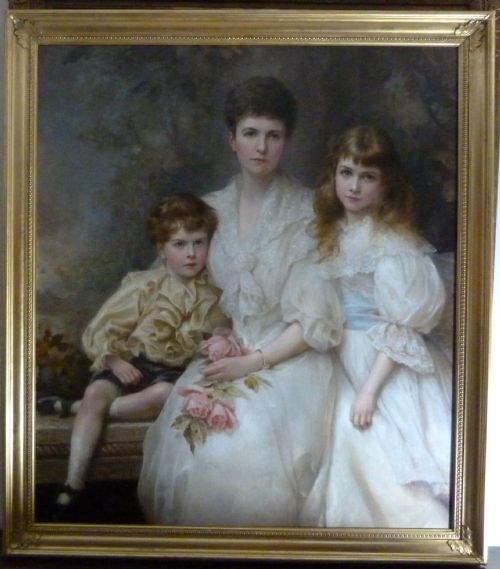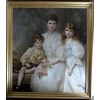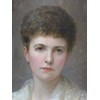Triple Portrait of The Hon. Mrs. Denham - Cookes and Her Children 1896, by Edward Hughes.
By Roy Precious From United Kingdom
| Shipping Destination | Single Item | Additional Items |
|---|
The estimated delivery time is (Mon-Fri) until the seller will dispatch the item. Actual delivery time will depend on your delivery location
Oil on canvas in giltwood frame, signed and dated "Edward Hughes 1896" lower left, on the stone plinth.
This superb triple portrait shows the Honourable Mrs. Denham-Cookes and her children Arthur Brownlow and Clara Evelyn in their garden at 16 Princes Gate, London. (This house is now the Iranian Embassy and is famous for its siege and capture by the SAS in 1980).
Their father was Colonel George Denham-Cookes, and his son Arthur followed him into the army, becoming a captain in the 24th Battn. London Regiment.
Prior to this he had become an M.A. Trinity Hall, Cambridge and a Member of the Inner Temple.
Arthur had married, in 1916, Ursula Bloom, the novelist, and in 1917 they had a son, Pip Denham-Cooke. Tragically, having survived the First World War, Arthur died of influenza in November 1918 aged 27.
EDWARD ROBERT HUGHES RWS (1849-1914) sometimes known as the last of the Pre-Raphaelites and nephew of the Pre-Raphaelite artist Arthur Hughes.
Edward Hughes is one of the painters whose works are, at the present time, more familiar than his name; paintings such as 'Midsummer's Eve' and the beautiful 'Night with her Train of Stars' are familiar when Hughes's name isn't.
He was born in the Clerkenwell district of London on November the 5th 1849, the only child of Edward and Harriet Hughes.
Edward entered the Royal Academy Schools; he was a conscientious hardworking student, who adopted a rigorous and thorough approach to his training. He became a member of an informal group of fellow students, who admired the art of Edward Burne-Jones. This group included Robert Bateman, Walter Crane, and Edward Clifford. Hughes also became close to Charles Fairfax Murray.
Edward Hughes started exhibiting at the Royal Academy in 1872, by which time he had a studio in Beaufort Street, Chelsea, and at this time met Edward Burne-Jones. Hughes also met the poet George MacDonald, and became engaged to one of his daughters, who unhappily died before the wedding could take place. He took a considerable time to recover from this loss, and did not exhibit at the Royal Academy at this time. In 1883, however, Hughes exhibited a painting of Mrs. George MacDonald, who would under happier circumstances have been his mother-in-law. The same year he married Emily Eliza Davies. Hughes then resumed exhibiting at the Royal Academy, virtually all the paintings being portraits. The art of Edward Hughes was also appreciated in other countries, particularly Austria and Germany, whose public collections have examples of his art.
In 1895 he achieved further international recognition at the Venice Biennale. Like so many other Victorian artists he was a painstaking perfectionist, making many meticulous preparatory studies. Hughes continued to produce portrait art, prints and posters, and also worked on Shakespearean themes. Hughes as an individual seems to have lacked personal vanity, and as an established rather than celebrated artist was content to work as a studio assistant to Holman Hunt, whose eyesight was failing. He worked under the direction of Hunt on his final and largest version of “The Light of the World,” now in St. Paul’s Cathedral.
Hughes died, aged 61, from infection after an operation.
SIZE:52 x 46 inches inc. frame.
PROVENANCE: by direct descent through the family.

-
Roy Precious
United Kingdom
We specialise in portraits from the 16th to the early 20th century, we also stock some 17th and 18th century ship paintings, furniture of the 17th and 18th centuries, and other artefacts dating from 200 B.C. to the 20th century.We have sold to many important collections including The Historic Royal Palaces collection and The Yale Center for British Art. Viewing is by appointment, or an arrangement can be made for the item to be brought to your home for inspection.







